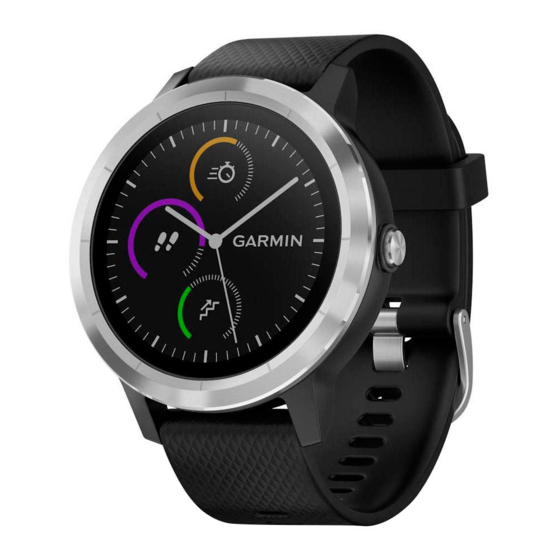Garmin VIVOACTIVE 3 Manuale d'uso - Pagina 9
Sfoglia online o scarica il pdf Manuale d'uso per Guarda Garmin VIVOACTIVE 3. Garmin VIVOACTIVE 3 28.
Anche per Garmin VIVOACTIVE 3: Manuale di risoluzione dei problemi (7 pagine), Manuale di risoluzione dei problemi (5 pagine), Faq (9 pagine), Manuale d'uso (28 pagine)

1
Hold the touchscreen.
2
Select Settings > User Profile > Heart Rate Zones.
3
Select Default to view the default values (optional).
The default values can be applied to running and cycling.
4
Select Running or Cycling.
5
Select Preference > Set Custom.
6
Select Based On.
7
Select an option:
• Select BPM to view and edit the zones in beats per
minute.
• Select %Max. HR to view and edit the zones as a
percentage of your maximum heart rate.
• Select %HRR to view and edit the zones as a percentage
of your heart rate reserve (maximum heart rate minus
resting heart rate).
8
Select Max. HR, and enter your maximum heart rate.
9
Select a zone, and enter a value for each zone.
10
Select Resting HR, and enter your resting heart rate.
Heart Rate Zone Calculations
Zone % of
Perceived Exertion
Maximum
Heart Rate
1
50–60%
Relaxed, easy pace,
rhythmic breathing
2
60–70%
Comfortable pace,
slightly deeper
breathing, conversation
possible
3
70–80%
Moderate pace, more
difficult to hold
conversation
4
80–90%
Fast pace and a bit
uncomfortable, breathing
forceful
5
90–100%
Sprinting pace,
unsustainable for long
period of time, labored
breathing
About VO2 Max. Estimates
VO2 max. is the maximum volume of oxygen (in milliliters) you
can consume per minute per kilogram of body weight at your
maximum performance. In simple terms, VO2 max. is an
indication of athletic performance and should increase as your
level of fitness improves.
On the device, your VO2 max. estimate appears as a number,
description, and level on the gauge. On your Garmin Connect
account, you can view additional details about your VO2 max.
estimate, including your fitness age. Your fitness age gives you
an idea of how your fitness compares with a person of the same
gender and different age. As you exercise, your fitness age can
decrease over time.
VO2 max. data and analysis is provided with permission from
The Cooper Institute
. For more information, see the appendix
®
(VO2 Max. Standard Ratings, page
www.CooperInstitute.org.
Getting Your VO2 Max. Estimate
The device requires wrist-based heart rate data and a timed 15
minute brisk walk or run to display your VO2 max. estimate.
1
Hold the touchscreen.
2
Select My Stats > VO2 Max..
Activity Tracking
Benefits
Beginning-level
aerobic training,
reduces stress
Basic cardiovascular
training, good
recovery pace
Improved aerobic
capacity, optimal
cardiovascular training
Improved anaerobic
capacity and
threshold, improved
speed
Anaerobic and
muscular endurance,
increased power
20), and go to
If you have already recorded a 15 minute brisk walk or run
outdoors, your VO2 max. estimate may appear. The device
displays the date your VO2 max. estimate was last updated.
The device updates your VO2 max. estimate each time you
complete an outdoor walk or run of 15 minutes or longer. You
can manually start a VO2 max. test to get an updated
estimate.
3
To start a VO2 max. test, swipe up, and select Test.
4
Follow the on-screen instructions to get your VO2 max.
estimate.
The VO2 max. test takes about 15 minutes. A message
appears when the test is complete.
Activity Tracking
The activity tracking feature records your daily step count,
distance traveled, intensity minutes, floors climbed, calories
burned, and sleep statistics for each recorded day. Your calories
burned includes your base metabolism plus activity calories.
The number of steps taken during the day appears on the steps
widget. The step count is updated periodically.
For more information about activity tracking and fitness metric
accuracy, go to garmin.com/ataccuracy.
Auto Goal
Your device creates a daily step goal automatically, based on
your previous activity levels. As you move during the day, the
device shows your progress toward your daily goal
If you choose not to use the auto goal feature, you can set a
personalized step goal on your Garmin Connect account.
Using the Move Alert
Sitting for prolonged periods of time can trigger undesirable
metabolic state changes. The move alert reminds you to keep
moving. After one hour of inactivity, Move! and the red bar
appear. Additional segments appear after every 15 minutes of
inactivity. The device also vibrates if vibration is turned on
(System Settings, page
14).
Go for a short walk (at least a couple of minutes) to reset the
move alert.
Sleep Tracking
While you are sleeping, the device automatically detects your
sleep and monitors your movement during your normal sleep
hours. You can set your normal sleep hours in the user settings
on your Garmin Connect account. Sleep statistics include total
hours of sleep, sleep levels, and sleep movement. You can view
your sleep statistics on your Garmin Connect account.
NOTE: Naps are not added to your sleep statistics. You can use
do not disturb mode to turn off notifications and alerts, with the
exception of alarms
(Using Do Not Disturb Mode, page
Intensity Minutes
To improve your health, organizations such as the U.S. Centers
for Disease Control and Prevention, the American Heart
Association
, and the World Health Organization, recommend at
®
least 150 minutes per week of moderate intensity activity, such
.
2).
5
